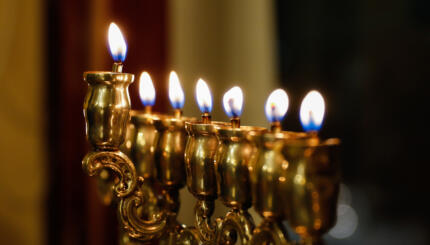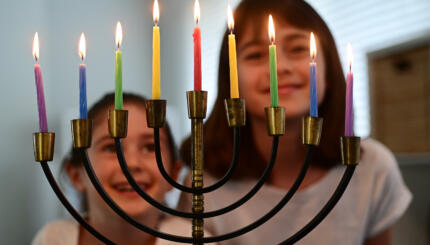Shabbat is a day of being, not doing. As interpreted by the rabbis, the day’s multitude of do’s and don’ts are essentially about not making anything, not destroying anything, and simply taking the world as we find it–for one day. The rest of the week, we Jews are exhorted to improve the world, better ourselves, and provide for our extended families in whatever roles in which we find ourselves. But this day: just be. Serve God not in changing the world, but in relaxing into what’s already there.
Waking Up
In a deep sense, this is the practice of meditation as well. There are many forms of meditative practice, but their essence is to see clearly into the truth of what is — like Shabbat, it’s not about not making or changing anything, or feeling a special way, but just waking up, in a focused way, to what’s already here. Most classical Jewish meditations do this by contemplating a particular object — a phrase, a sense-perception, even an idea–and focusing thought so resolutely that distractions drop away. In other traditions, attention is drawn to the barest perceptions of breath, or movement–not so much for the purpose of contemplation, but simply to slow down the motion of discursive thoughts. In both approaches, what one finds when distractions and thoughts are slowed down is that an important illusion is released: that the world matters only to the extent that it pleases me, my ego, and my desires.
Suppose a bit of food isn’t to your liking, or a sound is harsh, or grating. If you’re like me, your immediate reaction is to want to push it away–in other words, to change the momentary conditions of your life, in order to make them better. Meditation slowly trains the mind to be a little less centered on what in Jewish tradition is called the yetzer hara, the evil, or selfish inclination. As with Shabbat, the practice is simply to let it be. It’s not that the food will get tastier, or the sound will shift in quality, but your relationship to it can change.
All this may seem a bit irrelevant when talking about foods and sounds, but it’s not so irrelevant when working with sickness, or suffering, or people with whom it’s hard to get along. What it would be like to bring a little Shabbat–a little “let it be”–into such difficult places?
Well, you have to try it to find out. Reading about meditation without doing it is like reading a cookbook without tasting the recipes: you can get the general idea, but you’ll never really understand it. Fortunately, meditating on Shabbat is easy, since the Jewish tradition has already set up ideal conditions for doing it. Let’s look at a few practical ways to bring in the light–just to open the eyes a little wider to the everyday miracles of being.
The Sensation of Stopping
In religiously-observant homes, Friday afternoon is usually a hectic time. Food to prepare, emails to answer, floors to clean–it can get to be a little much, especially if you’ve been at work all day, or dealing with the kids. But then, when the candles are lit, a change takes place. Now there’s nothing to do. What’s done is done, what isn’t isn’t, and Shabbat is here. Whatever your Shabbat practice, I encourage you to try lighting candles before sunset as a way to mark this important transition. Don’t worry about doing it right; the main thing is to do it. Find a corner of your home which isn’t cluttered, set up a candlestick or two, and light. Close your eyes as you recite the blessing (if it’s your practice to do so; otherwise just close your eyes) and keep them closed for just five seconds more. Listen to the sounds around you–you have no responsibility for them, nothing to grab or to push away; just let them wash over you like an incidental symphony. Notice your body: see if there’s tension in your face, or your back, that you can just….relax. And take a nice, full breath, feeling the delicious sensation of inhaling and exhaling–an ordinary pleasure we’re too busy to enjoy.
On Shabbat, it’s said that we receive neshama yeteira, an extra soul. The word for soul here, neshama, is related to the word for breath, neshima. If you like, welcome in this “extra soul” that comes purely from being able to relax.
Open your eyes slowly, letting them feast on the visual sensation of the candle, or candles, burning. Focus on the light of the candle, not with a rigid wall of attention, but with an intention of receiving–of kabbalat shabbat. Just let it be whatever it will be. The secret of spirituality is that there’s no right way, no special feeling you’re supposed to have–only an open, loving relationship to any feeling, any sensation. Did a car honk just as you lit? Did your baby cry? No problem. As one of my teachers says, “it’s not what’s going on–it’s how you relate to it.”
Take as long as you like to linger over the Shabbat candles. It’s okay to be late to whatever comes next. See if, just by removing the sense of “what has to get done,” you can perceive their light with a bit more clarity than usual.
Moments of Silence
Since I do not use electricity on Shabbat, my home is much quieter on Saturdays than it is the rest of the week. No music, no TV, no computers–even in the noise of the city, my home is an island of silence. This silence extends, in traditional observance, to many parts of Shabbat–for example, in between ritually washing the hands and making the motzi blessing over bread. Ordinarily, silence can feel uncomfortable, and indeed, many people work hard to fill up these moments of quiet with songs or gestures of conversation. But silence is just like the essence of Shabbat, and meditation: not making, not doing–but being.
I suggest giving yourself random moments of silence throughout Shabbat. When you find your mind is running off somewhere, or the conversation has gotten louder than you really want–just pause. Let your body come into stillness, again relaxing any involuntary tensions that may have arisen. Take an artificial breath–a full, deep inhale, and an exhalation, with a sigh, that really clears out the lungs. And listen–not to the silence, since it probably won’t be totally silent–but to the silence of non-doing. Let the world be transparent to you, not colored by changes or preferences–just what it is. If you’re with other people, it’s okay if they think you’re weird; if you do this practice enough, you’ll learn to become so instantly relaxed that they’ll be jealous.
But relaxation is only the gateway. Try, in each moment of silence, to actually notice something you hadn’t noticed before: the quality of light, or your mood, or your feelings for another person. Maybe a scent, or a touch, or a presence of mind. Do this as often as you like–several times an hour, if you really like it. Just pause, relax, and drop into a kind of awareness that is normally the province of poetry.
Oneg Shabbos: Deepening Pleasure
Meditation isn’t about feeling good all the time–that’s narcotics, not spirituality. But, nu, it doesn’t hurt to feel good either, right? On Shabbat, to enjoy life is actually a mitzvah. You might’ve heard that sex is a “double mitzvah” on Shabbat. Well, it’s true; sex is a mitzvah on its own, and on Shabbat, since it’s enjoyable, it’s also a mitzvah of oneg shabbat, enjoying Shabbat.
Oneg Shabbat–in the Ashkenazic pronunciation, oneg shabbos–extends well beyond the bedroom, though. Here, Judaism actively invites delight in the senses (in eating and drinking and taking long naps) as well as in the soul (learning and reading and praying). In less opulent times, simply having a bit of chicken soup would have been a delectable and rare treat. Nowadays, though, I think we have to make an effort to enjoy. With so many improved means for unimproved ends, we probably have too many pleasures, not too few. And the result is less enjoyment of any.
Thus, oneg shabbos–becoming ever more exquisitely attuned to pleasure–takes some effort. Suppose you’re about to take that first bite of hallah on Friday night. Make the hallah the subject of meditation. Hold it in your hand, notice its feel, its smell. When you eat it, don’t scarf it all down right away; chew it ten, twenty, even thirty times, tasting the doughiness, the silkiness of it. Let yourself enjoy it the way you would a gourmet meal–why not? The neshama yeteira doesn’t come from magic; it comes from attention.
Or when you’re praying, don’t cram in as many words to as few minutes as possible. Stretch it out; if you don’t get to the whole service, so what? Delight in each poetic phrase, or a single lofty topic of contemplation. It’s said of one Hasidic rabbi that, one day, he never got past the first three words of the prayer service–modeh ani lefanecha, thankful am I before You–because he was so awed at being in the presence of the Divine.
Or even when you’re taking a walk: save the marathon for another day. Walk more slowly than usual, noticing how your perception shifts when you move a little slower. Make oneg shabbat part of your weekly practice, in whatever form makes sense for you: not adding more cherries onto the sundae, but deeply, sensuously enjoying the scoops you’ve already got.
Rabbi Nahman of Breslov said, “the world is full of light and mysteries both wonderful and awesome, but our tiny little hand shades our eyes and prevents them from seeing.” Shabbat is a day for moving away the hand; the desiring, the small self; the relentless pull of the ego. These are very simple meditation practices — no chants to remember, no postures to master — but they do the trick. Good Shabbos!
Sign up for My Jewish Learning’s RECHARGE, a weekly email with a collection of Shabbat readings and more to enhance your day of rest experience.
Hasidic
Pronounced: khah-SID-ik, Origin: Hebrew, a stream within ultra-Orthodox Judaism that grew out of an 18th-century mystical revival movement.
mitzvah
Pronounced: MITZ-vuh or meetz-VAH, Origin: Hebrew, commandment, also used to mean good deed.
Shabbat
Pronounced: shuh-BAHT or shah-BAHT, Origin: Hebrew, the Sabbath, from sundown Friday to sundown Saturday.



